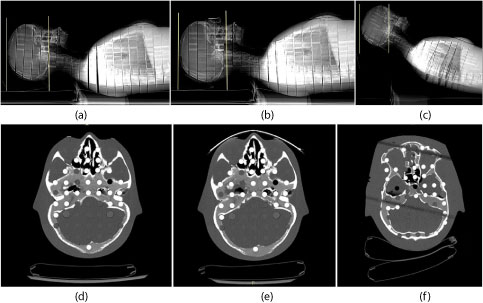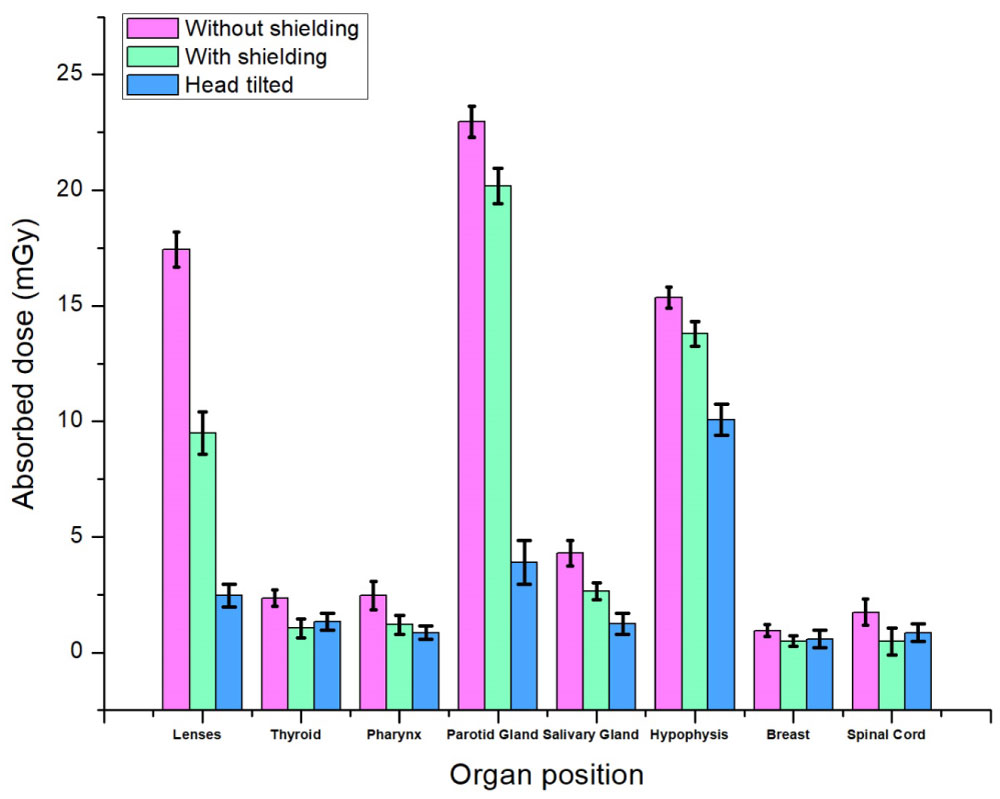Computed Tomography (CT) has become an important tool for diagnosing cancer and to obtain additional information on different clinical issues. Today, it is a very fast, painless and noninvasive test that can be performed high quality images. However, CT scans usually require a higher radiation exposure than a conventional radiography examination. Head CT scans are used for diagnosis of traumatic head injuries, infections and other diseases with instability. Based on this information, three head scans were performed using the routine protocol used in the radiodiagnosis service, programming the appliance with a voltage of 120 kV, an electrical current of 175 mA and a pitch of 0.984. Experiments were performed with a phantom with and without eye shielding and in supine with the head tilted. Three head CT scans were performed on anthropomorphic female phantom model Alderson Rando, from the cervical vertebra C1 to the top of skull, using a GE CT scanner, Discovery model with 64 channels. Radio chromic film strips were placed in the lenses and in nearby radiosensitive organs, such as: Thyroid, pharynx, hypophysis, salivary glands, spinal cord and breasts for each scan. After the phantom head CT scan, the radio chromic film strips were processed for obtaining digital images. Digital film strip images were worked to obtain the dose variation in each organ. The results show that the parotid gland received the highest dose, 22.97 mGy, according to the incidence of the primary X-ray beam.
Computed Tomography, Dosimetry, Bismuth shielding
Computed Tomography (CT) is the most common technique used for diagnostic purpose. It is a very fast test that can be performed high quality images. However, the increasing demand for CT had a considerable impact on doses provided to patients and on the exposure of the population as whole [1]. In fact, the worldwide average annual per-capita effective dose from medical procedures has approximately doubled in the last 10-15 years [2]. The dose evaluation in CT is one of many steps that can contribute for reducing patient doses. The head CT scans are commonly used for diagnosis of traumatic head injuries, infections and other diseases with in-stability, so it can be associated with a high radiation dose to organs such as lenses, parotid and salivary gland, pharynx and hypophysis, when compared with conventional radiology. The absorbed dose in organs with higher radiation sensitivity levels are object of continuous discussions, because of the risks that this can bring to health issues [3]. The lens is one of the organs located in the skull with relative high radiosensitivity, organ that is under consideration in this work of dosimetry, using elements such a radio chromic films, bismuth eye protector and the inclination of the skull before the CT scan.
The experiments were conducted using a GE CT scanner, Discovery model of 64 channels. An anthropomorphic female phantom model Alderson Rando was used to do the head scans. This phantom is builded with a human skeleton covered with a polymeric structure that simulate soft tissue. The body and head are structured in transected-horizontally into 2.5 cm thick slices. The slices that make up the body phantom have holes that allow placing dosimeters within the phantom [4,5]. The parameters of the acquisition protocols are shown in Table 1. The distance used for head CT scans with and without bismuth shielding were 140 mm and with the head tilted 120 mm.
Table 1: CT scan parameters. View Table 1
All CT scans were performed with the same acquisition protocol with the phantom placed in the isocenter of gantry. In Figure 1 is shown the phantom placed in the gantry isocenter. In a it is positioned in supine without bismuth, in b with the eye bismuth shielding and in c with the head tilted.
 Figure 1: Positioning of the Alderson female phantom in the gantry isocenter: Without bismuth shielding (a), with eye bismuth shielding (b) and in supine with the head tilted (c). View Figure 1
Figure 1: Positioning of the Alderson female phantom in the gantry isocenter: Without bismuth shielding (a), with eye bismuth shielding (b) and in supine with the head tilted (c). View Figure 1
Dose measurements have been performed using GAFCHROMIC XR-CT radio chromic film strips to register the individual doses in the organs of interest such as lenses, thyroid, pharynx, breasts, hypophysis, spinal cord, parotids and salivary gland in the phantom. The Figure 2 shows three lateral radiography (scout) and three axial head images, with and without an eye bismuth shielding of 1 mm thick and a scan with the head tilted without the use of eye shielding.
 Figure 2: Scout's and axial head CT images: Without eye shielding (a, d), with eye bismuth shielding (b, e) and head tilted (c, f). View Figure 2
Figure 2: Scout's and axial head CT images: Without eye shielding (a, d), with eye bismuth shielding (b, e) and head tilted (c, f). View Figure 2
The radiochromic films are self-developing dosimetry films, insensitive to visible light making it easy to work with during analysis and provide greater spatial resolution in the sub millimeter range. They have been used extensively in combination with flatbed document scanners to measure patient doses [6,7]. Metrological reliability of the radio chromic films was demonstrated through homogeneity and repeatability tests and by calibrating it in a reference radiation for CT (RQT9) that were reproduced in the Calibration Laboratory of the Development Center of Nuclear Technology (CDTN/CNEN) [7,8]. The Figure 3 shows digital images of radiochromic film irradiated (a) and not exposed (b).
 Figure 3: Radio chromic film strips. Not irradiated (a) and irradiated (b). View Figure 3
Figure 3: Radio chromic film strips. Not irradiated (a) and irradiated (b). View Figure 3
Absorbed doses in the organs positions such as: thyroid, lenses, pharynx, hypophysis, breast, spinal cord, parotid gland and salivary gland are shown in Table 2. These results allow to observe that the use of bismuth shield led to a decrease in radiation dose deposited in the eyes and all organs studied.
Table 2: Average absorbed dose in some organ positions in the phantom during head CT scans with and without bismuth shielding on eyes. View Table 2
To compare the results of absorbed dose between bismuth shielding and head tilted with the phantom position supine, the lenses absorbed doses were 45.6% and 85.9% smaller for the use of bismuth shielding and head tilted, respectively. The highest recorded dose was 22.97 mGy in the parotid gland that stressed the situation of unnecessary radiation exposure. The influence of the bismuth shielding and the positioning of the head on the table has direct response levels of absorbed dose in the radio chromic films. In organs such as lenses, pharynx, parotid glands, salivary glands and hypophysis, the influence of the head tilted in absorbed dose rates is greater compared with the use of bismuth shielding. It is expected that eye shielding would degrade image quality and would increase the image noise, however the results of this work suggests that it might be an acceptable procedure to be used for dose reduction mainly during CT examinations that would provide high doses to radiosensitive organs. The influence of the bismuth shielding and the positioning of the head tilted with respect to the dose rates table absorbed to different organ position is presented in Figure 4.
 Figure 4: Absorbed dose in organ. View Figure 4
Figure 4: Absorbed dose in organ. View Figure 4
Using the graphic in the Figure 4, it is possible to verify that the CT scan with the head tilted promotes a considerable reduction in absorbed dose in lenses, parotid gland, hypophysis, pharynx and salivary gland. In thyroid, breasts and spinal cord as the use of bismuth shielding as head tilted promote a small decrease in the absorbed dose.
The absorbed doses were determined during head CT scans with and without eye bismuth shielding and with the head tilted of an Alderson Rando male anthropomorphic phantom. Dose values were significantly reduced when use the head tilted CT scan. The use of eye bismuth shielding promotes a reduction in the organ absorbed dose. These results suggest that the use of bismuth shielding or the head tilted promotes reduction in organ dose, but the head tilted is better and is not necessary the use of any device.
The authors are grateful to CAPES, CNPq and FAPEMIG for the support. Also, the Technology Center in Nuclear Medicine of UFMG is acknowledged for producing the images and CDTN/CNEN for the use of the phantom.